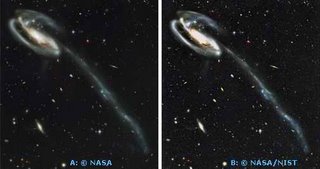Friday, December 22, 2006
Hubble: NIST Math Technique Opens Clearer Window on Universe

A fast, efficient image enhancement technique developed at the National Institute of Standards and Technology (NIST) and originally applied to improving monochrome microscope images has proved itself equally effective at the other end of the scale - sharpening details on color images of distant galaxies produced by the Hubble Space Telescope**. That the technique's practical value would span from inner space to outer space was a welcome surprise to NIST mathematician Alfred Carasso*.
Removing blur is a problem common to almost all imaging, from home snapshots to scientific instrumentation. Mathematically, blurring can be thought of as a set of mathematical operations that are applied to every point in an image and that result in that point being spread out and diffused. In principle, if you know the blurring function, the exact set of operations, you can remove the blur by delicate numerical analysis, being careful not to amplify noise.
Continued at "Hubble: NIST Math Technique Opens Clearer Window on Universe" [Astronomy]
-------
Based on the journal Optical Engineering paper:
"APEX blind deconvolution of color Hubble space telescope imagery and other astronomical data"
by Alfred S. Carasso
The APEX method is a noniterative direct blind deconvolution technique that can sharpen certain kinds of high-resolution images in quasi real time. The method is predicated on a restricted class of blurs, in the form of 2-D radially symmetric, bell-shaped, heavy-tailed, probability density functions. Not all images can be usefully enhanced with the APEX method. However, the method is found effective on a broad class of galaxy images, including Hubble space telescope advanced camera for surveys (ACS) color imagery. APEX-detected optical transfer functions that successfully sharpen these images are very far from Gaussian, and of a type seldom found in the imaging literature. Several examples are given where significantly sharper and visually striking reconstructions are obtained, with sharpening confirmed by the tripling or quadrupling of image gradient norms.
-------
*Dr. Alfred S. Carasso's (homepage) research interests:
Leading authority on 'deconvolution' and other ill-posed problems of applied mathematics. Invented 'slowly divergent' computational schemes for inverse heat conduction calculations in gun barrels, rocket nozzles, and nuclear reactors. Developed 'pulse probing and continuous deconvolution' technique for dynamic characterization of structural networks, ultrasonic testing in NDE, and system identification in electronic black-boxes. Invented 'slow evolution' constraint for stabilizing digital image deblurring computations in presence of noise, with applications in biomedical imaging, (X-rays, CT, PET, SPECT, MRI), acoustic imaging, undersea imaging, imaging through atmospheric turbulence, and night vision systems. Patents pending on new procedure for image restoration.
-------
*Info on the Hubble Space Telescope:
Launched in April of 1990 and poised for many more years of trailblazing science ranging from our own solar system to the edge of the observable universe, NASA's Hubble Space Telescope is fulfilling the hopes astronomers have long held for a large, optically superb telescope orbiting above the Earth’s distorting atmosphere and providing uniquely clear and deep views of the cosmos.
The only one of NASA's four "Great Observatories" (Hubble, Compton Gamma-Ray Observatory, Chandra X-Ray Observatory, and Spitzer Space Telescope) that is serviceable by Space Shuttle astronauts, Hubble has seen its capabilities grow immensely in its sixteen historic years of operation. This has been the direct result of the installation of new, cutting-edge scientific instruments and more powerful engineering components. Replacement of aging or failed parts has been an important part of servicing and has been responsible for the telescope's longevity.
All of the Great Observatories have a particular range of light, or "electromagnetic radiation," to which they are designed and are sensitive. Hubble’s domain extends from the ultraviolet, through the visible (to which our eyes are sensitive), and to the near-infrared. In terms of the wavelength of light, Hubble’s coverage ranges from 1,200 Angstroms in the ultraviolet (1 Angstrom = 1 hundred-millionth of a centimeter) to 2.4 microns (24,000 Angstroms) in the near-infrared. Hubble’s UV-to-near-IR spectral range is a key piece of "astronomical real estate" - a dominant range of wavelengths emitted by stars and galaxies - and Hubble takes advantage of this access with both imaging and spectroscopy.
-------
Image Citations:
A (Left): Galaxy UGC 10214 ("Tadpole"), imaged in 2002 by the Advanced Camera for Surveys (ACS) aboard NASA's Hubble Space Telescope, shows what NASA called a "Whitman's Sampler of galaxies" from the universe's 13-billion-year evolution.
B (Right): Applying the APEX method to the Tadpole galaxy image brings both "foreground" objects and background galaxies into significantly sharper focus.
Add to: CiteUlike | Connotea | Del.icio.us | Digg | Furl | Newsvine | Reddit | Yahoo